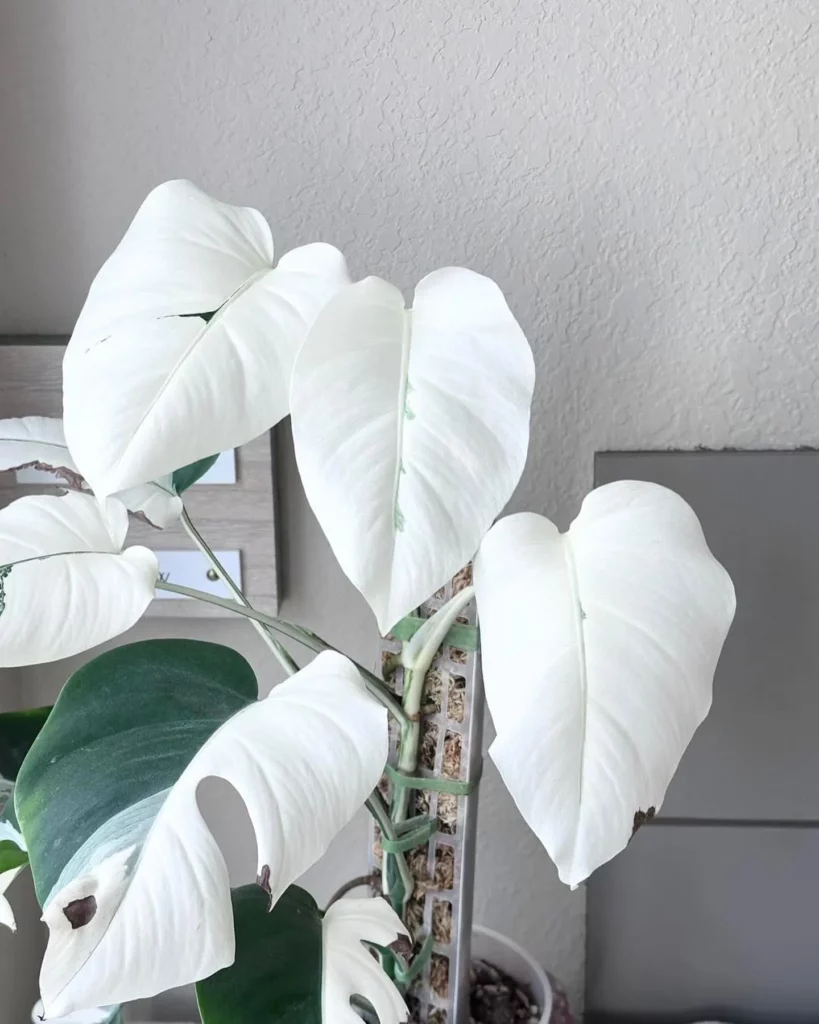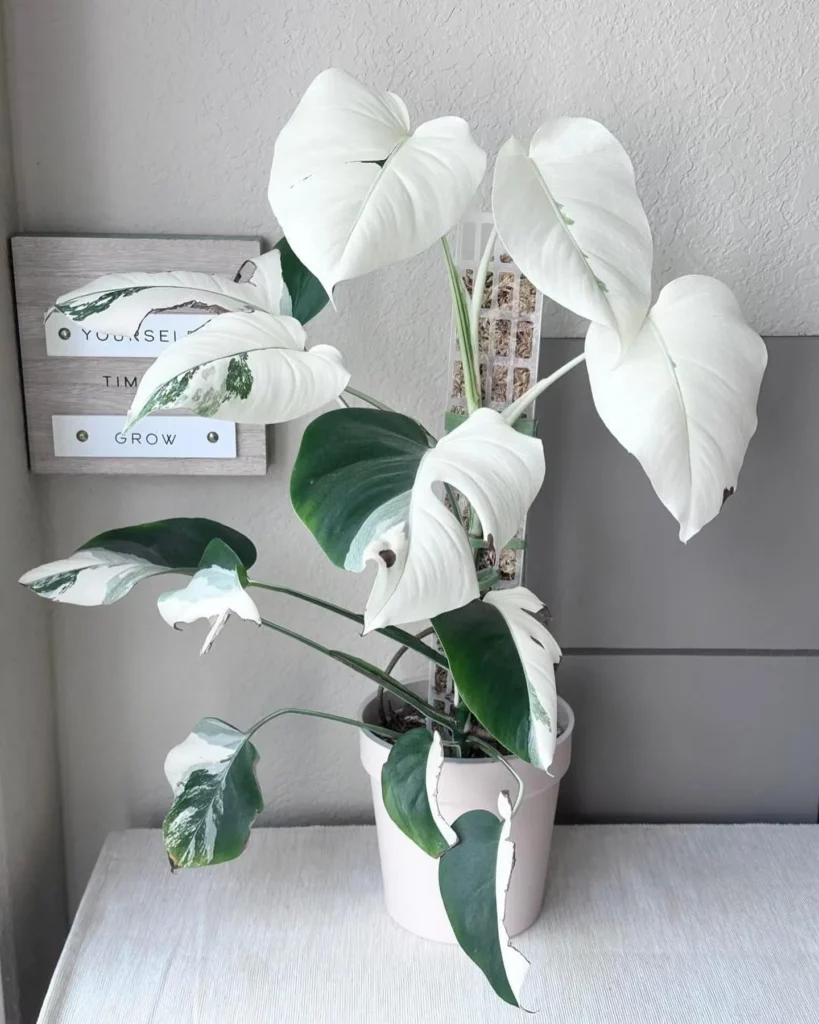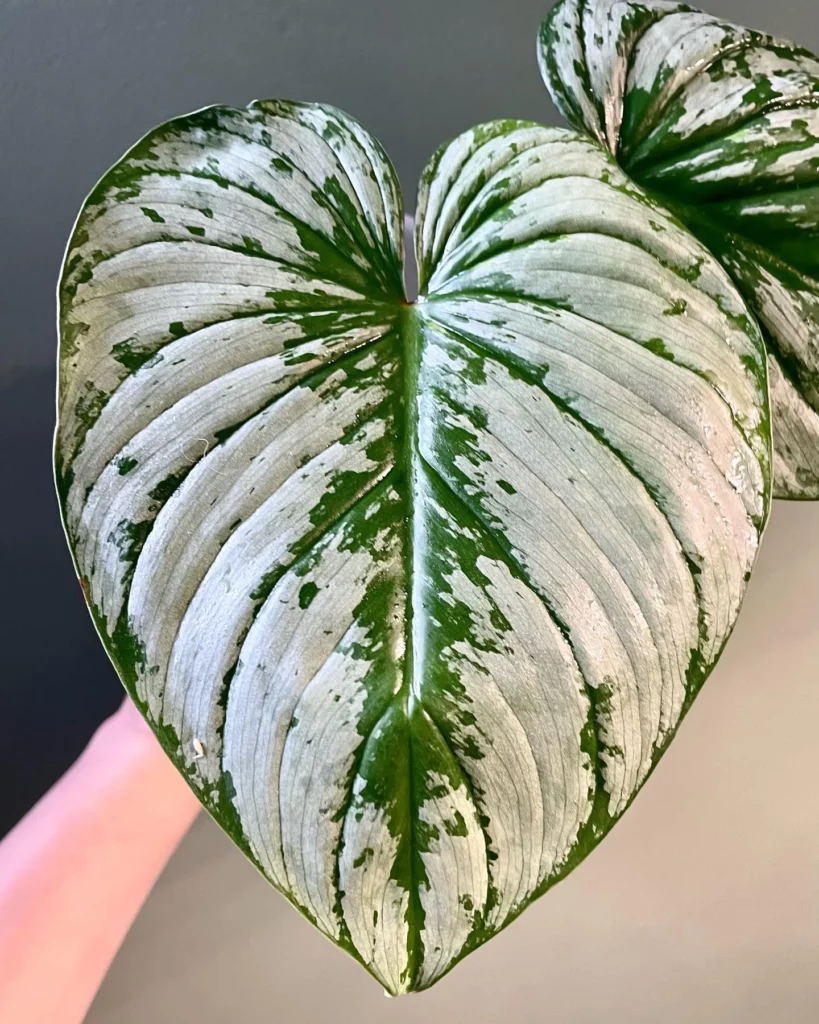The White Princess Philodendron is known for its eye-catching white variegated foliage, which adds a touch of elegance and uniqueness to any room. Unlike other philodendron varieties that climb or vine, this plant has a self-heading growth habit, making it a perfect choice for those who prefer a more compact and upright plant.
Appearance of White Princess Philodendron



The White Princess Philodendron is a stunning plant with distinct features that make it stand out among other philodendron varieties. Its heart-shaped leaves are adorned with striking white variegation on a backdrop of vibrant green foliage, creating a beautiful contrast. The glossy texture of the leaves adds to its overall appeal.
When grown indoors, the White Princess Philodendron can reach a height of up to 4 feet, making it a statement plant in any space. Unlike other climbing philodendrons, it maintains an upright growth habit, eliminating the need for a support pole. This compact and self-heading plant is ideal for those who want a stunning centerpiece without the hassle of managing climbing vines.
Light Requirements for White Princess Philodendron



The White Princess Philodendron is a stunning tropical plant that requires specific light conditions to maintain its vibrant white variegation. Providing the right amount and type of light is crucial for the plant’s overall health and appearance.
To meet the light requirements of your White Princess Philodendron, it is best to place it in a spot where it can receive bright, indirect sunlight. This means locating it near a window with filtered light or using a sheer curtain to diffuse the sunlight.
It is recommended to ensure that your White Princess Philodendron receives at least six hours of indirect light daily. This prevents the fading of the variegated foliage and helps the plant thrive.
While the plant requires sufficient light, it is important to avoid exposing it to direct, harsh sunlight. Direct sunlight can scorch the delicate leaves of the White Princess Philodendron, leading to damage and discoloration.
- Place the plant where it can receive bright, indirect sunlight.
- Ensure the plant receives at least six hours of indirect light daily.
- Avoid exposing the plant to direct, harsh sunlight to prevent leaf damage.
Watering White Princess Philodendron



The White Princess Philodendron requires regular watering to maintain its health and vibrant appearance. To ensure optimal growth, it is essential to follow proper watering practices.
- Keep the soil consistently moist: The White Princess Philodendron prefers moist soil but not waterlogged conditions. Ensure that the top few inches of soil are evenly moist.
- Avoid overwatering: It is crucial to allow the top layer of soil to dry out slightly before watering again. Overwatering can lead to root rot and other moisture-related issues.
- Check soil moisture: Before watering, gently insert your finger into the soil to assess its moisture level. If the top inch feels dry, it’s time to water the plant.
- Drain excess water: After watering, make sure to allow any excess water to drain out from the pot. This helps prevent waterlogging and ensures adequate oxygen supply to the roots.
Fertilizing White Princess Philodendron


The White Princess Philodendron is a stunning plant with beautiful variegated foliage. To ensure its growth and vibrancy, regular fertilization is essential during the growing season.
As a heavy feeder, the White Princess Philodendron requires a balanced, diluted nitrogen fertilizer. Apply the fertilizer every few weeks to provide the necessary nutrients for large, healthy foliage and vibrant variegation.
Before fertilizing, ensure that the soil is already moist to prevent fertilizer burn. Watering the plant before fertilization helps to distribute the nutrients evenly and avoid any damage to the roots.
It’s important to note that fertilization should be stopped during the plant’s dormant winter phase. During this time, the plant’s growth slows down, and it requires less nutrients.
Potting White Princess Philodendron
The White Princess Philodendron, known for its stunning white variegation, requires proper potting to ensure optimal growth and health. When selecting a potting mix, it’s crucial to choose a rich and well-draining medium that can provide adequate nutrients and moisture for the plant.
One option is to use a commercial aroid mix specifically formulated for philodendrons. These mixes often contain a blend of organic materials, such as peat moss and coconut coir, along with perlite or vermiculite for improved drainage.
Alternatively, you can create your own potting mix by combining equal parts of high-quality potting soil, perlite, and orchid bark. This homemade blend promotes excellent drainage while retaining enough moisture for the plant’s roots.
Soilless mixtures can also be used for potting the White Princess Philodendron. Options like peat and vermiculite or sphagnum peat moss provide a lightweight and moisture-retentive medium that is suitable for this tropical beauty.
When repotting, it’s essential to choose a pot that is slightly larger in diameter than the current one. This allows the plant’s roots to have ample space to grow and expand. Repotting is typically recommended every two to three years during the spring or summer growing season.
Propagation of White Princess Philodendron
Expanding your collection of White Princess Philodendrons is an exciting and rewarding experience. Thankfully, propagating this stunning plant is relatively straightforward, offering you the opportunity to create new plants to share with friends or fill your space with even more beauty.
There are two primary methods of propagating the White Princess Philodendron: stem cuttings and division.
Stem Cuttings
To propagate the White Princess Philodendron using stem cuttings, begin by selecting a healthy stem with at least two well-developed leaves at the top. Look for a section with a few nodes towards the bottom as well. This is where the new roots will sprout.
Once you have selected a suitable cutting, make a clean cut just below a node on the stem. Allow the cut end to callus over for a day or two to prevent excessive moisture loss during the propagation process.
Next, place the cutting in a jar of water, ensuring that the cut end is submerged. Position the jar in a bright area with indirect sunlight and check the water level regularly to ensure it remains sufficient for rooting.
After a few weeks, you should start to see roots sprouting from the bottom nodes of the cutting. Once the roots are well-established, you can transfer the cutting to a well-draining potting mix. Be gentle when repotting to avoid damaging the delicate roots.
Division
Another method of propagating the White Princess Philodendron is through division. This is typically done during the early spring when the plant is showing signs of new growth.
To divide the plant, carefully remove it from its current pot, taking care not to damage the roots. Gently separate the sections, ensuring each division has its own healthy roots and stems.
Once divided, repot each section into its own well-draining potting mix, ensuring the roots are covered and stable. Water lightly and provide the proper care to encourage new growth in each divided plant.
Growth and Development of White Princess Philodendron
The White Princess Philodendron is a stunning plant that undergoes gradual growth and development, adding elegance to any indoor space. While it may not grow as quickly as other philodendron species, this plant has its unique charm and rewards patient caretakers with its beauty.
On average, the White Princess Philodendron grows up to a foot per year, exhibiting a modest but steady growth rate. This slow pace allows for better control and gives plant enthusiasts the opportunity to shape the plant according to their desired aesthetic.
Under optimal conditions, this philodendron can reach a height of up to 4 feet tall. Its lush foliage can expand to approximately 18 inches wide, creating a lush and vibrant presence in any room. The White Princess Philodendron’s growth pattern is upright, eliminating the need for support poles or frequent maintenance.
Pruning is generally not required for the White Princess Philodendron unless the plant starts outgrowing its designated space. In such cases, healthy stems can be carefully cut and propagated, allowing for the creation of new plants while controlling the size of the existing one.
Pests and Diseases of White Princess Philodendron
While the White Princess Philodendron is a relatively hardy plant, it can still face some common pests and diseases. It’s important to be aware of these potential issues and take proactive measures to protect your plant’s health.
Pests
Although the White Princess Philodendron is not highly susceptible to pests, a few common ones can still pose a threat to its well-being. Fungus gnats, mealybugs, and thrips are known culprits that may infest your plant.
Fungus gnats are tiny black flies that thrive in moist potting soil. They lay their eggs in the soil, and the larvae feed on the plant’s roots, potentially causing damage. Mealybugs are small, cotton-like insects that often infest the foliage, hiding in leaf joints and crevices. They feed on the plant’s sap, weakening it over time. Thrips are slender insects that feed on plant tissues, causing discoloration and distortions.
To control these pests, you can use insecticidal soap or natural neem oil. These options are effective in eliminating the pests while being safe for your plant.
Diseases
The White Princess Philodendron can be susceptible to certain fungal diseases, especially in high humidity environments. Leaf spots are a common issue that can occur when the plant leaves are exposed to excess moisture or inadequate ventilation.
To address fungal diseases, it’s crucial to maintain proper air circulation and avoid overwatering. If you notice signs of leaf spots, you can treat them with a fungicide specifically formulated for houseplants. Regular inspection and maintenance, including pruning any affected foliage, can help prevent the spread of fungal diseases.
All in all, ensuring a healthy growing environment with proper care and attention will go a long way in preventing pest infestations and diseases for your White Princess Philodendron.
Common Issues and Troubleshooting for White Princess Philodendron
The White Princess Philodendron, like any other houseplant, can encounter some common issues that may indicate problems with its care. One issue you may notice is a fading variegation and leggy growth. This could be a sign that your plant is not receiving sufficient bright, indirect light. To remedy this, consider moving the plant closer to a window or providing supplemental artificial lighting.
Another issue that can occur is yellowing and dropping leaves. This can be caused by overwatering, underwatering, or inadequate light. To troubleshoot, check the moisture level of the soil and adjust your watering routine accordingly. Ensure that the plant is receiving enough light, as insufficient light can also lead to leaf yellowing and drop.
If you notice brown, crispy leaf tips on your White Princess Philodendron, it may be an indication of underwatering, low humidity, or excessive direct sunlight. To resolve this issue, adjust your watering schedule and consider increasing humidity levels around the plant. Avoid placing the plant in direct sunlight, as it can scorch the leaves.
Lastly, curling leaves can be caused by cold drafts or low humidity levels. To address this, make sure that the plant is not placed near cold drafts, such as air conditioning units or open windows. Increase humidity by misting the leaves regularly or using a humidifier.
Regularly observing your White Princess Philodendron and making adjustments to its care routine can help prevent and resolve these common issues, ensuring that your plant thrives and maintains its health and beauty.
FAQ
How do I care for the White Princess Philodendron?
The White Princess Philodendron is relatively easy to care for. It requires bright, indirect sunlight, well-draining soil, regular watering, and high humidity. However, it is important to note that the plant is toxic to both pets and humans.
What does the White Princess Philodendron look like?
The White Princess Philodendron has heart-shaped leaves with striking white variegation on green foliage. The leaves have a glossy texture and can grow up to 4 feet tall indoors. It has an upright habit and does not require a support pole like other climbing philodendrons.
How much light does the White Princess Philodendron need?
The White Princess Philodendron requires bright, indirect sunlight to maintain its vibrant white variegation. It should receive at least six hours of indirect light daily to prevent fading of the variegation. However, direct, harsh sunlight should be avoided as it can scorch the delicate foliage.
How often should I water the White Princess Philodendron?
The White Princess Philodendron requires regular watering to keep the soil consistently moist but not soggy. It is important to allow the top few inches of soil to dry out before watering again to prevent overwatering and root rot. Watering should be done when the soil is slightly dry, and any excess water should be drained to avoid waterlogging.
How should I fertilize the White Princess Philodendron?
The White Princess Philodendron is a heavy feeder and requires regular fertilization during the growing season. A balanced, diluted nitrogen fertilizer should be applied every few weeks, ensuring the soil is moist before fertilizing to prevent fertilizer burn. Fertilization should be stopped during the dormant winter phase.
What type of potting mix should I use for the White Princess Philodendron?
The White Princess Philodendron should be potted in a rich, well-draining potting mix. Commercial aroid mixes or a homemade blend of equal parts potting soil, perlite, and orchid bark can be used. Soilless mixtures like peat and vermiculite or sphagnum peat moss can also work. Repotting should be done every two to three years during the spring or summer growing season, using a pot that is slightly larger in diameter.
How can I propagate the White Princess Philodendron?
The White Princess Philodendron can be propagated from stem cuttings during the active spring or summer growth season. Cuttings should be taken with at least two healthy leaves at the top and a few nodes towards the bottom. The cut base of the stem should be allowed to callus over before placing it in a jar of water. Once roots have sprouted, the cutting can be transferred to a well-draining potting mix. Division can also be done during the early spring by separating the plant and repotting the divided sections.
How fast does the White Princess Philodendron grow?
The White Princess Philodendron is a relatively slow grower compared to other philodendron species, with an average growth rate of up to a foot per year. It can reach a height of up to 4 feet tall and 18 inches wide indoors. Pruning is not necessary unless the plant is growing too large for its space, in which case healthy stems can be cut and propagated to create new plants.
What pests and diseases are common for the White Princess Philodendron?
While the White Princess Philodendron is not highly susceptible to pests, common pests that can affect it include fungus gnats, mealybugs, and thrips. These can be controlled with insecticidal soap or natural neem oil. Fungal diseases, such as leaf spots, can occur in high humidity environments and should be treated with a fungicide. Regular inspection and maintenance can help prevent and address any pest or disease issues.
What are some common issues and troubleshooting tips for the White Princess Philodendron?
The White Princess Philodendron can experience fading variegation and leggy growth with insufficient bright, indirect light. Yellowing and dropping leaves can indicate overwatering, underwatering, or lack of proper light. Brown, crispy leaf tips can be a sign of underwatering, insufficient humidity, or too much direct sunlight. Curling leaves can be caused by cold drafts or low humidity. Regular observation and adjustment of care can help address these issues and maintain the plant’s health.




